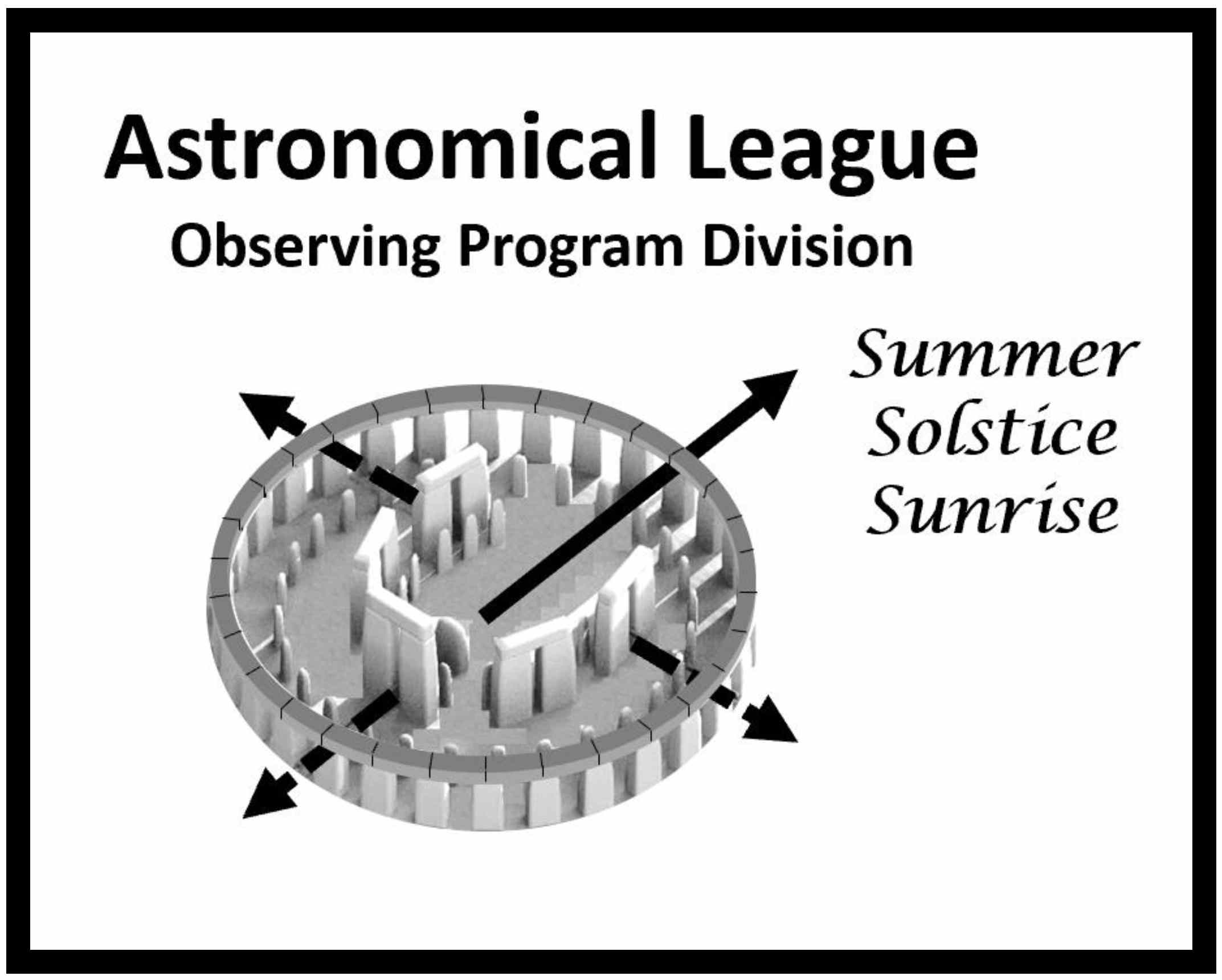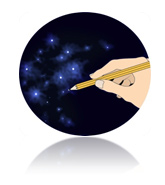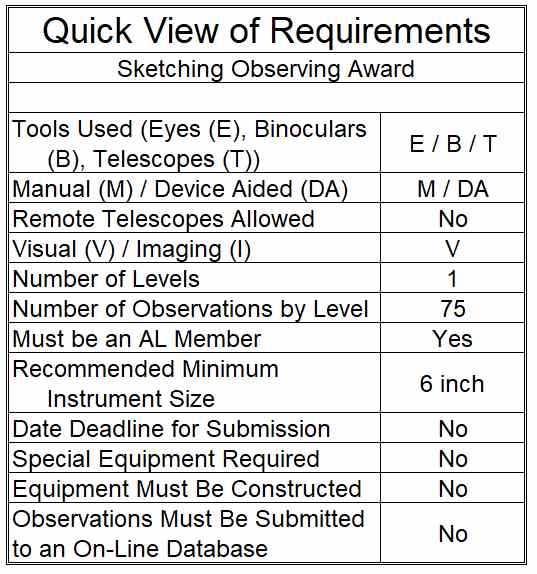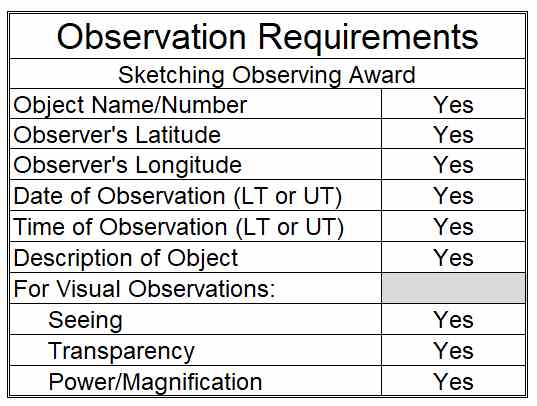Sketching Observing Program Coordinator:Cindy L. Krach, DVM |
  |
Introduction
| Aloha and welcome to the Astronomical League Sketching Observing Program. This award was created by members of the Haleakala Amateur Astronomers on the beautiful island of Maui, Hawaii. We hope this Observing Program will help you gain a greater appreciation for sketching astronomical objects and enhance your skills in recording observations.
Historically astronomers employed sketches to record their observations and ground-breaking discoveries. With the advent of astrophotography, one might question why anyone would want to sketch astronomical objects. There is no need to compare the two as they are different forms of recording information. However, while astrophotography requires a sizable investment, computer software & time to process images, sketching requires only paper, a pencil and a few other inexpensive items. There are many advantages to sketching astronomical objects:
|

|
Background Information
Overview & Purpose:
The Sketching Observing Program was not created specifically for “artists.” It is for everyone regardless of the level of experience or artistic ability. So before you say “But I can’t sketch” you may surprise yourself over time with a little patience, care, and practice. There are tutorial links and other resources listed at the end of this page that are highly informative and recommended for those new to sketching astronomical objects. These resources provide an excellent starting point for those who have never sketched or are intimidated by the process. There are also advanced tips for more detailed sketching and for those with more experience. The main focus of the Observing Program is not to make artists out of amateur astronomers but to help slow down the observing process and improve observing skills over time. As with anything, practice will improve the ability to recreate what is observed in the eyepiece.
The object list (as a PDF file or an MS Excel Spread Sheet) was created by members of the Haleakala Amateur Astronomers (HAA) of Maui, Hawaii and includes lunar, planetary, double stars, nebula, open and globular clusters, and more. The last column in the spreadsheet list designates the relative sketching difficulty of the object. Level 1 is simple and Levels 2 and 3 are more complex. Those new to astronomical sketching may wish to start with Level 1 objects and progress from there. To qualify for the award certificate and pin observers must sketch 75 of 114 objects on the list. Most of the objects are well within the reach of amateur astronomers in the northern hemisphere, although the list also contains some southern objects from which to choose.
Special thanks to those members of HAA who worked together to create this Observing Program;
Cindy L. Krach, Steve McGaughey, Rob Ratkowski, Jan Roberson, Robert Zaleski, & Dr. J.D. Armstrong . The pin design sports a hand sketching a colorized Pleiades, created by Cindy Krach & Steve McGauhey of HAA, with special thanks to graphic artist Kathyrn Ratkowski. For their financial support of this program, we would like to gratefully acknowledge the University of Hawaii’s Institute for Astronomy, as well as members of Haleakala Amateur Astronomers.
Requirements and Rules
This certification is available to members of the Astronomical League, either through their local astronomical society or as members at large. If you are not a member and would like to become one, check with your local astronomical society, search for a local society on the Astronomical League Website (click here), or join as a Member-At-Large in the AL Store.
|
 |
Certificate & Pin
To qualify for the AL Sketching Observing Program Certificate and Pin, sketch at least 75 objects from the list provided.
Upon completion, please have your sketches reviewed by a local astronomy club officer, ALCor, or local awards coordinator. An email is then sent to the Observing Program Coordinator for confirmation of completion. You may also submit your observations directly to the Observing Program Coordinator. Please mail copies of your sketches & logs to the Observing Program Coordinator, along with your name, address, astronomy club or Astronomical League affiliation, e-mail address, and phone number. Please do not send your original logs, as they will not be returned. Upon verification of your observations, your certificate and pin will be forwarded either to you or your society’s Awards Coordinator, whomever you choose.
Suggested Supplies
- Paper – Observers may use one of the templates provided or one of their own creation. Sketch circles should be a minimum of 3″ diameter. We recommend printing on heavy-weight paper such as 28# weight, or a sketch pad such as Strathmore white and/or black. Experimenting with white & black paper as well as colored pencils is encouraged.
- Variety of pencils including 2B, charcoal pencils, colored pencils
- Gummy kneaded eraser
- Blending stumps or tortilla
- Sharpener or sandpaper on a small board
- A clipboard with a rubber band attached to the bottom to hold the paper down
- Charcoal sticks – black & white
- Red light to clip on clipboard
- Fixative spray to lightly fix the sketch once finished
To receive your certification, please contact the Sketching Observing Program Coordinator. Include your name, mailing address, email address, phone number, society affiliation, and to whom the certification should be sent.
Sketching Observing Program CoordinatorCindy L. Krach, <span”>DVM |
 |
Notes:
Acknowledgements:
- The Haleakala Amateur Astronomers would like to gratefully acknowledge Jeremy Perez, Thomas McCague, Peter Vercauteren, Alexander Massey, and Erika Rix for allowing links to their excellent sketching resources.
Sketch Templates:
- Astronomy Sketch Log
- Astronomy Sketch Log (large)
- http://www.perezmedia.net/beltofvenus/files/LogSheetAstro_Left.pdf
Links:
- Observing List as PDF File
- Observing List as MS Excel Spread Sheet
- Access Sketching Resources
- Find Your Observing Program Award



